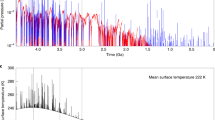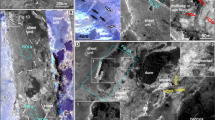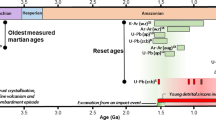Abstract
The surface of Mars has long been seen as a basaltic, monotonous world, but observations in the past decade have revealed more petrological diversity. Orbital and in situ rover investigations show that Mars developed a silica-rich crust early in its history. This is supported by studies of the Martian regolith breccia Northwest Africa (NWA) 7533 (and paired meteorites). When and to what extent rocks on Mars differentiated, and which geodynamical process could lead to this evolution, is still unclear. Here we use petrology and in situ geochemical analyses to document the presence of quartz in lithic clasts of NWA 7533. The clasts have a granitic composition with a mineral assemblage dominated by quartz, potassium feldspar and plagioclase. Such quartz-bearing clasts are the most evolved silicic rocks yet recognized among differentiated Martian lithologies. These clasts suggest the likely existence of pre-Noachian granitic rocks on Mars that formed in the presence of water. In bulk composition they resemble the oldest terrestrial rocks (Acasta gneisses, Canada) and also rocks from the large Sudbury impact structure. Therefore, we suggest that the combined action of hydrothermal activity and impact melting could have triggered the formation of granitic rocks and evolved crust on early Mars and Earth.
This is a preview of subscription content, access via your institution
Access options
Access Nature and 54 other Nature Portfolio journals
Get Nature+, our best-value online-access subscription
$32.99 / 30 days
cancel any time
Subscribe to this journal
Receive 12 print issues and online access
$259.00 per year
only $21.58 per issue
Buy this article
- Purchase on SpringerLink
- Instant access to full article PDF
Prices may be subject to local taxes which are calculated during checkout




Similar content being viewed by others
Data availability
All data used for the figures (main, Supplementary Information and Extended Data) and the tables are available via Zenodo at https://doi.org/10.5281/zenodo.14623410 (ref. 54).
References
Lapôtre, M. G. A. et al. Mars as a time machine to Precambrian Earth. J. Geol. Soc. 179, jgs2022-047 (2022).
Bouley, S. et al. A thick crustal block revealed by reconstructions of early Mars highlands. Nat. Geosci. 13, 105–109 (2020).
Phillips, M. S. et al. Extensive and ancient feldspathic crust detected across north Hellas rim, Mars: possible implications for primary crust formation. Geology 50, 1182–1186 (2022).
Sautter, V. et al. In situ evidence for continental crust on early Mars. Nat. Geosci. 8, 605–609 (2015).
Humayun, M. et al. Origin and age of the earliest Martian crust from meteorite NWA 7533. Nature 503, 513–516 (2013).
Wittmann, A. et al. Petrography and composition of Martian regolith breccia meteorite Northwest Africa 7475. Meteorit. Planet. Sci. 50, 326–352 (2015).
Santos, A. R. et al. Petrology of igneous clasts in Northwest Africa 7034: implications for the petrologic diversity of the Martian crust. Geochim. Cosmochim. Acta 157, 56–85 (2015).
Hewins, R. H. et al. Regolith breccia Northwest Africa 7533: mineralogy and petrology with implications for early Mars. Meteorit. Planet. Sci. 52, 89–124 (2017).
McCubbin, F. M. et al. Geologic history of Martian regolith breccia Northwest Africa 7034: evidence for hydrothermal activity and lithologic diversity in the Martian crust. J. Geophys. Res. 121, 2120–2149 (2016).
Hu, S. et al. Ancient geologic events on Mars revealed by zircons and apatites from the Martian regolith breccia NWA 7034. Meteorit. Planet. Sci. 54, 850–879 (2019).
Costa, M. M. et al. The internal structure and geodynamics of Mars inferred from a 4.2-Gyr zircon record. Proc. Natl Acad. Sci. USA 117, 30973–30979 (2020).
Kingma, K. J. & Hemley, R. J. Raman spectroscopic study of microcrystalline silica. Am. Mineral. 79, 269–273 (1994).
Aoudjehane, H. C., Jambon, A., Reynard, B. & Blanc, P. Silica as a shock index in shergottites: a cathodoluminescence study. Meteorit. Planet. Sci. 40, 967–979 (2005).
Hewins, R. et al. Pervasive shock melting at >65 GPa in a Martian basalt, the shergottite Northwest Africa 14672. Meteorit. Planet. Sci 59, 640–669 (2023).
Götze, J., Plötze, M. & Habermann, D. Origin, spectral characteristics and practical applications of the cathodoluminescence (CL) of quartz - a review. Mineral. Petrol. 71, 225–250 (2001).
Leroux, H., Reimold, W. U. & Doukhan, J.-C. A TEM investigation of shock metamorphism in quartz from the Vredefort Dome, South Africa. Tectonophysics 230, 223–239 (1994).
Stöffler, D. & Langenhorst, F. Shock metamorphism of quartz in nature and experiment: I. Basic observation and theory. Meteoritics 29, 155–181 (1994).
Bechtold, A. et al. Lunar meteorite Northwest Africa 11962: a regolith breccia containing records of titanium‐rich lunar volcanism and the high alkali suite. Meteorit. Planet. Sci. 56, 971–991 (2021).
Xu, H. et al. Crystallographic evidence for simultaneous growth in graphic granite. Gondwana Res. 27, 1550–1559 (2015).
Terada, K. & Bischoff, A. Asteroidal granite-like magmatism 4.53 gyr ago. Astrophys. J. 699, L68 (2009).
Agee, C. B. et al. Unique meteorite from early Amazonian Mars: water-rich basaltic breccia Northwest Africa 7034. Science 339, 780–785 (2013).
Mattey, D., Lowry, D. & Macpherson, C. Oxygen isotope composition of mantle peridotite. Earth Planet. Sci. Lett. 128, 231–241 (1994).
Bindeman, I. N. Triple oxygen isotopes in evolving continental crust, granites, and clastic sediments. Rev. Mineral. Geochem. 86, 241–290 (2021).
Kleine, B. I., Stefánsson, A., Halldórsson, S. A., Whitehouse, M. J. & Jónasson, K. Silicon and oxygen isotopes unravel quartz formation processes in the Icelandic crust. Geochem. Perspect. Lett. https://doi.org/10.7185/geochemlet.1811 (2018).
Savage, P. S., Georg, R. B., Williams, H. M. & Halliday, A. N. The silicon isotope composition of the upper continental crust. Geochim. Cosmochim. Acta 109, 384–399 (2013).
Marin-Carbonne, J., Chaussidon, M. & Robert, F. Micrometer-scale chemical and isotopic criteria (O and Si) on the origin and history of Precambrian cherts: implications for paleo-temperature reconstructions. Geochim. Cosmochim. Acta 92, 129–147 (2012).
Armytage, R. M. G., Georg, R. B., Savage, P. S., Williams, H. M. & Halliday, A. N. Silicon isotopes in meteorites and planetary core formation. Geochim. Cosmochim. Acta 75, 3662–3676 (2011).
Huang, R. & Audétat, A. The titanium-in-quartz (TitaniQ) thermobarometer: a critical examination and re-calibration. Geochim. Cosmochim. Acta 84, 75–89 (2012).
Wieczorek, M. A. et al. InSight constraints on the global character of the Martian crust. J. Geophys. Res. 127, e2022JE007298 (2022).
Nyquist, L. et al. Rb–Sr and Sm–Nd isotopic and REE studies of igneous components in the bulk matrix domain of Martian breccia Northwest Africa 7034. Meteorit. Planet. Sci. 51, 483–498 (2016).
Rampe, E. B. et al. Mineralogy of Vera Rubin Ridge from the Mars Science Laboratory CheMin instrument. J. Geophys. Res. 125, e2019JE006306 (2020).
Viennet, J.-C. et al. Tardi-magmatic precipitation of Martian Fe/Mg-rich clay minerals via igneous differentiation. Geochem. Perspect. Lett. https://doi.org/10.7185/geochemlet.2023 (2020).
Filiberto, J. et al. Shergottite Northwest Africa 6963: a pyroxene-cumulate Martian gabbro. J. Geophys. Res. 123, 1823–1841 (2018).
Leroux, H. & Cordier, P. Magmatic cristobalite and quartz in the NWA 856 Martian meteorite. Meteorit. Planet. Sci. 41, 913–923 (2006).
Udry, A., Gazel, E. & McSween, H. Y. Jr Formation of evolved rocks at Gale Crater by crystal fractionation and implications for Mars crustal composition. J. Geophys. Res. 123, 1525–1540 (2018).
Moyen, J.-F. The composite Archaean grey gneisses: petrological significance, and evidence for a non-unique tectonic setting for Archaean crustal growth. Lithos 123, 21–36 (2011).
Mojzsis, S. J., Harrison, T. M. & Pidgeon, R. T. Oxygen-isotope evidence from ancient zircons for liquid water at the Earth’s surface 4,300 Myr ago. Nature 409, 178–181 (2001).
Valley, J. W. et al. 4.4 billion years of crustal maturation: oxygen isotope ratios of magmatic zircon. Contrib. Mineral. Petrol. 150, 561–580 (2005).
Cavosie, A. J., Valley, J. W. & Wilde, S. A. in Earth’s Oldest Rocks 2nd edn (eds Van Kranendonk, M. J. et al.) Ch. 12 (Elsevier, 2019); https://doi.org/10.1016/B978-0-444-63901-1.00012-5
Wilde, S. A., Valley, J. W., Peck, W. H. & Graham, C. M. Evidence from detrital zircons for the existence of continental crust and oceans on the Earth 4.4 Gyr ago. Nature 409, 175–178 (2001).
Moyen, J.-F. & Martin, H. Forty years of TTG research. Lithos 148, 312–336 (2012).
Blichert-Toft, J. & Albarede, F. AGU Fall Meeting Abstracts (AGU, 2008).
Drabon, N. et al. Destabilization of long-lived Hadean protocrust and the onset of pervasive hydrous melting at 3.8 Ga. AGU Adv. 3, e2021AV000520 (2022).
Johnson, T. E. et al. An impact melt origin for Earth’s oldest known evolved rocks. Nat. Geosci. 11, 795–799 (2018).
Reimink, J. R., Chacko, T., Stern, R. A. & Heaman, L. M. Earth’s earliest evolved crust generated in an Iceland-like setting. Nat. Geosci. 7, 529–533 (2014).
Latypov, R., Chistyakova, S., Grieve, R. & Huhma, H. Evidence for igneous differentiation in Sudbury Igneous Complex and impact-driven evolution of terrestrial planet proto-crusts. Nat. Commun. 10, 508 (2019).
Naldrett, A. J. & Hewins, R. H. in The Geology and Ore Deposits of the Sudbury Structure Ontario Geological Survey Special Publication Vol. 1 (eds Pye, E. G. et al.) 235–251 (Ontario Ministry of Natural Resources, 1984).
Grieve, R. A. F., Cintala, M. J. & Therriault, A. M. in Processes on the Early Earth (eds Reimold, W. U. & Gibson, R. L.) https://doi.org/10.1130/2006.2405(02) (Geological Society of America, 2006).
Black, B. A. & Marchi, S. Buoyant impact partial melts on ancient Mars. J. Geophys. Res. 129, e2023JE008040 (2024).
Khan, A. et al. A geophysical perspective on the bulk composition of Mars. J. Geophys. Res. 123, 575–611 (2018).
Seitz, S., Baumgartner, L. P., Bouvier, A.-S., Putlitz, B. & Vennemann, T. Quartz reference materials for oxygen isotope analysis by SIMS. Geostand. Geoanalytical Res. 41, 69–75 (2017).
Audetat, A. et al. Characterisation of a natural quartz crystal as a reference material for microanalytical determination of Ti, Al, Li, Fe, Mn, Ga and Ge. Geostand. Geoanalytical Res. 39, 171–184 (2014).
Seitz, S. et al. Short magmatic residence times of quartz phenocrysts in Patagonian rhyolites associated with Gondwana breakup. Geology 44, 67–70 (2016).
Malarewicz, V. et al. Evidence for pre-Noachian granitic rocks on Mars from quartz in meteorite NWA 7533. Zenodo https://doi.org/10.5281/zenodo.14623410 (2025).
Baratoux, D. et al. Petrological constraints on the density of the Martian crust. J. Geophys. Res. 119, 1707–1727 (2014).
Peck, W. H., Valley, J. W., Wilde, S. A. & Graham, C. M. Oxygen isotope ratios and rare earth elements in 3.3 to 4.4 Ga zircons: ion microprobe evidence for high δ18O continental crust and oceans in the early Archean. Geochim. Cosmochim. Acta 65, 4215–4229 (2001).
Valley, J. W., Bindeman, I. N. & Peck, W. H. Empirical calibration of oxygen isotope fractionation in zircon. Geochim. Cosmochim. Acta 67, 3257–3266 (2003).
Acknowledgements
This research benefited from funding from the CNRS-PNP and the MNHN-ATM to B.Z. and O.B. H.L. thanks the electron microscopy facility of the Chevreul Institute, University of Lille, and funding through the CHEMACT project supported by the Ministère de l’Enseignement Supérieur de la Recherche, the region Hauts-de-France and the Métropole Européenne de Lille. The National High Magnetic Field Laboratory is supported by the National Science Foundation through NSF/DMR-2128556* and the State of Florida (MH). In Lausanne, thanks are due to T. Bovay, F. Plane and the SwissSIMS team for maintaining the instrument. In Paris, thanks are due to O. Boudouma for access to the cathodoluminescence service, and M. Fialin and N. Rividi for their help with the electron microprobe (CAMPARIS, Paris). In Lille, thanks are due to D. Troadec for his help with FIB.
Author information
Authors and Affiliations
Contributions
O.B. and B.Z. conceived this study. V.M., O.B., B.Z., D.D., S.P. and R.H.H. acquired the petrological and mineralogical data (SEM, Raman, electron microprobe). J.M.-C., D.R., A.S.B. and E.B. acquired the SIMS data. H.L. acquired the TEM data. All authors were involved in the interpretation of the data. O.B. led the writing of the paper to which all co-authors contributed with comments and inputs.
Corresponding author
Ethics declarations
Competing interests
The authors declare no competing interests.
Peer review
Peer review information
Nature Geoscience thanks Alan Hastie, Michael Phillips and the other, anonymous, reviewer(s) for their contribution to the peer review of this work. Primary Handling Editor: Alison Hunt, in collaboration with the Nature Geoscience team.
Additional information
Publisher’s note Springer Nature remains neutral with regard to jurisdictional claims in published maps and institutional affiliations.
Extended data
Extended Data Fig. 1 Variability and location of CLMR in several sections of NWA 7533.
(a) SEM image in BSE mode of the NWA 7533 section (SP10) with its different components: CLMR (Clast Laden Melt Rock), Mo (monzonitic clast), No (Noritic clast) and quartz-bearing CLMR. (b) SEM EDS mapping of the NWA 7533 section (SP10) with Si, Mg, Fe and P represented. All quartz fragments are located within a distinct Mg-poor and Ca-rich quartz-bearing CLMR in the right part of the section. This quartz-bearing CLMR (highlighted in yellow in C, D and E), including its inner vitrophyric melt (in orange) can be traced through 3 distinct polished sections in the same piece of NWA 7533: SP10 (c), SP9 (d) and SP11 (e). Extrapolating the shape of this zone at the edge of each section suggests a roundish shape with a vitrophyric core. Several CLMR (in pink numbered from 1 to 3) and some prominent lithic clasts (circled in white) can be traced through the sections, highlighting the spatial continuity.
Extended Data Fig. 2 Petrology of the quartz-bearing CLMR.
(a) SEM BSE map of the quartz-bearing CLMR where all the quartz grains, including those contained in quartz-bearing clasts, were found in section SP10. (B) The close-up BSE map illustrates the varied and complex microtextures observed in this melt zone, including pyroxene clumps with a plagioclase aureole as described in Hewins et al.8. A fine-grained rim surrounds the inner vitrophyric melt (b).
Extended Data Fig. 3 Chemical composition of CLMR in NWA 7533.
Chemical composition of the quartz-bearing CLMR (in yellow) and of other CLMR (in pink, see Extended Data Fig. 2 for location of each CLMR from corresponding numbers) compared to the bulk matrix of NWA 75337. (a) CaO versus MgO, (b) Al2O3 versus FeO. Average compositions are derived from the average of electron microprobe data obtained on a series of ten to twenty 12*9 μm raster point analyses. Error bars are standard deviations for these analyses (see Supplementary Table 1).
Extended Data Fig. 4 Petrology and chemical composition of quartz-bearing clasts.
SEM BSE images and corresponding SEM EDS mapping of four quartz-bearing clasts (QBC) identified in the quartz-bearing CLMR of NWA 7533. The lithic clasts shown are (a) clastno. 1, (b) clast no. 3, (c) clast no. 4, and (d) clast no. 5. Qtz = quartz, Kfs = K-feldspar, Pl = plagioclase, Px = pyroxene, Il = ilmenite, Ap = apatite.
Extended Data Fig. 5 TEM imaging of FIB sections in quartz.
Mosaic of TEM images in low magnification bright-field mode of two FIB sections from Qtz no. 13 (a) and Qtz no. 10 (b). In both cases, quartz appears as single crystal with only minor defects. Bragg fringes are disrupted by planar defects interpreted as shock features at low intensity.
Extended Data Fig. 6 High-resolution images within the FIB sections obtained by TEM in bright field mode.
(a) Growth twins at the edge of the section from Qtz no. 10. Mechanical twinning in (0001) in Qtz no. 13 (b,c). (d) Lamellae of amorphous material in (\(10\bar{1}3\)) together with mechanical twins within Qtz no. 10. (e) Beam of planar defects in (\(10\bar{1}1\)) within the Qtz no. 2. (f) Small mineral inclusions linked by a thin planar defect within Qtz no. 13.
Extended Data Fig. 7 Mineral composition in quartz-bearing clasts.
Composition of pyroxene (a) and feldspar (b) in quartz-bearing clasts (clasts 1 to 4) and other individual fragments found in the quartz-bearing CLMR and in the matrix of the breccia8. Compositions were analysed by electron microprobe. Mineral phases in clast #5 are too small to be analysed by electron microprobe.
Extended Data Fig. 9 Geochemistry of quartz-bearing clasts.
Geochemical diagrams comparing the composition of the quartz-bearing clasts with other lithic clasts in the NWA 7533 (and paired meteorites) breccia6,7,8, and terrestrial rocks like the Archean TTGs36, the Acasta gneiss and Idiwhaa tonalite44. (a) Na2O/K2O versus SiO2, (b) FeO versus MgO, (c) FeO versus SiO2.
Extended Data Fig. 10 Isotopic comparison with Jack Hills zircons.
(a) Calculation of δ18O for quartz in equilibrium with zircon versus temperature for the Hadean Jack Hills zircons. Zircon δ18O data are from 6 zircons in Peck et al.56 and 18 zircons in Mojzsis et al.37, and the oxygen fractionation is taken from Valley et al.57. Each point is the average of calculated values and the error is their standard deviation. (b) The δ18O values measured in the Martian quartz are shown in the histogram plot for comparison.
Supplementary information
Supplementary Information
Supplementary Notes 1 and 2, Fig. 1 and Tables 1–6.
Rights and permissions
Springer Nature or its licensor (e.g. a society or other partner) holds exclusive rights to this article under a publishing agreement with the author(s) or other rightsholder(s); author self-archiving of the accepted manuscript version of this article is solely governed by the terms of such publishing agreement and applicable law.
About this article
Cite this article
Malarewicz, V., Beyssac, O., Zanda, B. et al. Evidence for pre-Noachian granitic rocks on Mars from quartz in meteorite NWA 7533. Nat. Geosci. 18, 207–212 (2025). https://doi.org/10.1038/s41561-025-01653-z
Received:
Accepted:
Published:
Issue date:
DOI: https://doi.org/10.1038/s41561-025-01653-z



